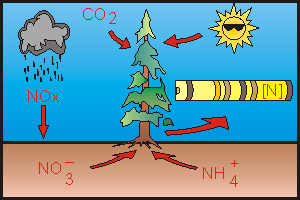DENDROCHEMISTRY COLLOQUIUMGEOS 595 E (one unit) |

|
Paul Sheppard (W. Stadium 105-C1, 621-6474,
sheppard@ltrr.arizona.edu)
General objectives of this course
Primary: Learn by practice with a dendrochemical analysis (inorganic, non-isotopic) of selected tree rings for nitrogen content. Review other general concepts, techniques, issues, and applications of dendrochemistry as an environmental science. Concepts on the measurement and interpretation of nitrogen in tree rings were funded in part by a Small Grant for Exploratory Research From the National Science Foundation (0087007).
Colloquium meetings
We will meet for five weeks, about three hours per week. One hour per week will be spent in lecture/discussion, where we'll review pertinent literature and learn concepts. The other two hours per week will be in lab time, either together or individually, to actually do the many steps of dendrochemical analysis. These activities may take less than two hours during some weeks, more during other weeks.
Obligations and Grading
- As a group, I plan for us to give a noon-hour LTRR talk on our colloquium activities and results.
- Students will write a typical research report, ~8 pages of text plus figures, due just after the LTRR presentation. Each student will have access to all data and results from all others, if desired.
I do not plan to have any examinations is this colloquium. Final grades will be determined as follows:
- Participation in lab activities and lecture-discussions (40%)
- Participation in LTRR presentation, if we do one (10%)
- Written research report (50%): To be eligible for a grade of "B", the Introduction and Discussion sections must contain citations of all journal papers that we discuss in lecture. To be eligible for a grade of "A", the Introduction and Discussion sections must contain citations of other journal articles of your choosing from a list of pertinent research. Grammar and clarity will count.
Office hours and readings
Paul's office hours are essentially all the time. I'm generally around the Tree-Ring Lab most of the daytime, so your chances are good of randomly finding me for help. You could also e-mail questions and I'll reply as soon as possible.
Readings will be available in pdf format from the course
website (http://www.ltrr.arizona.edu/~sheppard/dendrochemistry/).
Note: For reading PDF files, you'll need Adobe Acrobat Reader, at
least 4.0, which you can get free HERE: 
| Flexible Schedule of Activities (subject to change) | |
|---|---|
| Week |
Activity |
| 1 | Lecture: Why do Dendrochemistry: generally, specifically our
project, bibliography Reading: Lewis 1995: Dendrochemistry in regional ecosystem health assessments: the forest health monitoring experience. Reading: Cutter and Guyette 1993: Anatomical, chemical and ecological factors affecting tree species choice in dendrochemistry studies. Lab: Chisel cores, bag pieces Lab: Grind control cores |
| 2 | Lecture: Tree physiology matters: N in plants, translocation
after ring formation, uptake mechanisms Reading: Poulson et al.: 1995. N isotope variation in tree rings. Reading: Merrill and Cowling: 1966. Role of N in wood deterioration. Optional Reading: Heaton: 1990. 15N/14N ratios of NOx. Lab: Grind, bag and extract treated cores Lab: Grind, bag and extract treated cores |
| 3 | Lecture: CNS analysis of plant tissue: a form of ion
chromatography Reading: Artiola: On Gas Chromatography Reading: Park et al. 1992. Some advances in sample preparation techniques for X-ray densitometry and image analysis of increment cores. Lab: Pack samples for measuring Lab: Pack samples for measuring |
| 4 | Lecture: Environmental context of N and CO2: Effect of
pollution in tree growth, role of soils Reading: LaMarche et al. 1984. Increasing atmospheric CO2: Tree ring evidence for growth enhancement in natural vegetation. Reading: Tilman et al. 1997. Human alteration of the global Nitrogen cycle: cause and consequences. Lab: Measure wood Lab: Measure wood |
| 5 | Lecture: Other dendrochemistry applications: soil
acidification by proxy, non-essential element uptake Reading: Lab: Do figures and other results Lab: Prepare Powerpoint presentation of results |
| 5 | Noon-hour LTRR presentation |
| 6 | Research paper due |